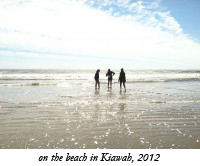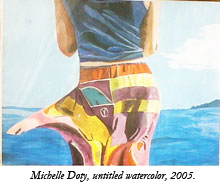What We're Reading Now
We Can All Use a Little Creative Inspiration from Time to Time
23 March 2012
After spending a few hours on the beaches of Kiawah reading Spark: How Creativity Works by Julie Burstein, Michelle quickly realized that blissfully quiet beaches and long bike rides might be just what she needs when her creative juices stop flowing.
Tags: creativity, michelle read
I don’t do the typical beach read. I never have. My idea of an amazing vacation book is one that elicits happiness and makes me think. I like to come away from vacation feeling as if my mind and body have had a nice break from the stress of the “real world,” but not that they have gone unengaged. It’s a delicate balance…and a quirk that some of my friends find highly amusing.

At any rate, that helps to explain how spring break found me sitting on the beach in Kiawah reading Spark: How Creativity Works. Burstein is the producer of Studio 360, the popular Public Radio show with Kurt Andersen, and Spark is a book of vignettes from the show’s interviews that seek to gain access to the minds of some of the most creative thinkers of the era.
While I love the idea of the form—a series of vignettes all linked by a common exploration of the realm where “art and reality” collide—I was left wanting more (surely novelist Joyce Carol Oates’ method of transforming “the dream world into sentences” is one that warranted more than two pages). From the title I was looking for a better understanding of “how creativity works,” so was admittedly a bit confused when the glimpses into the minds of some of these great artists, thinkers, designers, creative people from all walks of life, were pretty sparse. Even so, the glimpses gave me some insight and inspiration that I could apply in my own life as I remember how my own creative processes work best.
I grew up as ‘the artistic one,’ the artist, the writer, the storyteller, but since beginning high school and being put on the ‘academic track,’ my creative spirit in the most obvious ‘artistic’ sense was somewhat squelched. Even so, I’ve often found that the same creative process I used to practice for my artistic endeavors (prepare, work for hours, pause and wonder when it would be good enough, persist) are just as valuable to all aspects of my life now—personal, educational and professional. Reading the stories of these creative thinkers allowed me to really assess my own current creative process and re-commit to what I know works best for me. The last two vignettes, Knowing When to Stop and When to Keep Going as well as Celebrate! (both self-explanatory) were particularly helpful in reminding me of two very important stages that I sometimes forget to complete in my own process.

The most important lesson I gleaned from this book is that everyone’s creative process is unique, and while mirroring someone else’s might work, Spark is much more likely to inspire you to find your own. One of my favorite quotes from the book comes from Burstein’s intro to Chapter 5, Imagination’s Wellspring: “The essential gift is to be open to wonder, and to let that wonder spark your creativity.” I think that’s a great lesson for us all as we remember to imagine and be open to things that could be.







Comments
Our Comment Policy:
Our blog posts are only half of the conversation. What our readers have to say is equally important to us, and we're grateful for all the comments that continue the dialog.
To ensure that the discussion here is as useful as possible to all of our readers, please be respectful of our contributors and refrain from harassing, threatening and/or vulgar language. We reserve the right to screen and remove any comments from the site. If you have a question about a comment or want to discuss our policy, please contact us. We'll talk it over.
Peter Morrissey
Mar 24, 2012
Enjoyed your writing.
Suggest taking a look at old school creative problem solving—a good place is senectics and also idea mapping. Creativity is random but can be linear building on opposites, metaphors and visual processes
Wrte a narrative or story and then draw a picture or make a 3dimensional model. Video of like objects also helps.